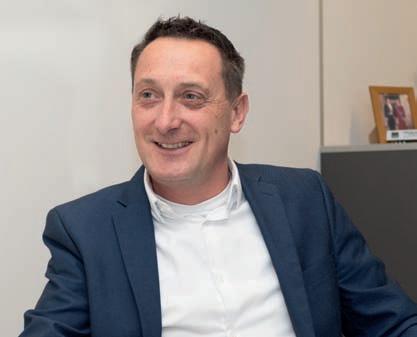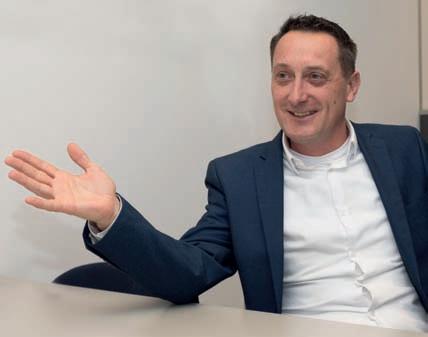
5 minute read
Taking over: Marco van Lomwel
Taking over
On 31 January 2020, Peter de Graaff, General Manager of Euro-Mit Staal, officially went into retirement after leading the company for 28 years. Following in his footsteps is Marco van Lomwel, who previously held the position of Manager Accounting & Finance at the company.
Q: Mr van Lomwel, could you tell us a little bit about your background? A: I was born and raised in Zeeland. I currently live in OostSouburg. My professional background lies in accounting and finance. After working in the financial department at a different company for several years, I started working for Euro-Mit Staal in 2002. Back then, around 30 people worked at the company, and I was the only person in the accounting department. Then we started growing. Our employee numbers grew along with the tonnage we handled. We now have 75 people working here.
Q: How did you end up in your new role as general manager? A: We discussed Mr de Graaff’s retirement within the management team, and I was approached for the role. Working as general manager will be quite different from accountancy, but I am up for the challenge. I especially look forward to communicating with all the different departments. We have a great group of people at Euro-Mit Staal, so I thoroughly enjoy getting the opportunity to work with them.
Q: What have you learned from your predecessor? A: I have worked with Mr de Graaff for many years. He was here from the start, when our current site was nothing but a grassy field. Together with Mitsui in Japan, he built up our company from scratch. It is now up to the rest of us to pick up where he left off. The social character that Mr de Graaff has provided the company with is definitely something I want to continue. I believe people achieve most when they enjoy their job, when they can continue their self-development through training, and when they feel supported. I am dedicated to making that effort.
Q: How did Euro-Mit Staal end up in Vlissingen? A: Euro-Mit Staal is part of Mitsui & Co, a large Japanese trading firm with numerous branches. The electrical steel that we handle was already part of their product portfolio. Mitsui used to supply electrical steel for the European transformer industry all the way from Japan. If a customer needed another steel coil, it would sometimes take six months to arrive. For that reason, they started looking for a suitable location for a European affiliate. They considered Hamburg, Rotterdam, and Antwerp, but none of those ports ticked all the required boxes. Vlissingen, however, did. And so Mitsui built their European

MArcO vAn LOMwEL, GEnErAL MAnAGEr OF EurO-Mit StAAL.
office here back in 1992. It turned out to be a smart decision; we have been thriving ever since. We have expanded our site twice, in 2007 and again in 2012. The entire building has been outfitted with motion-sensorised led lighting. And just last month, the installation of 3,200 solar panels on our roof was completed. The generated electricity will be used by an external party, but it is roughly equal to the amount of power required by our machines on a yearly basis. We are a conscious company, so we try to limit our impact on the environment wherever we can.
Q: What is Euro-Mit Staal’s core business? A: We started out slitting thin gauge steel plate to smaller coils from bigger coils, and that is still our main business. During our 2011-2012 expansion, we added a cutting machine that also allows us to cut laminations from the coils. The transformer market is fairly conservative; the design may change, but not much else. However, the current market situation provides us with lots of opportunities. The increasing demand for electricity, partially due to the popularity of electrical cars, as well as the surge in wind turbine construction, are all factors for a vivid electrical steel market.
Q: Do you plan on making any changes in Euro-Mit Staal’s activities? A: To build a transformer, individual laminations are stacked on top of each other. At present, we send the cut laminations to external parties who stack them and build the transformer. We are keen to investigate whether it would be worthwhile to do the stacking process ourselves. There is no rush though. We want to continue doing what we do best. And we are very good at slitting coils.
Q: Where do your operators learn their skills? A: There is no specific educational requirement for our machine operators. We just look for enthusiastic, technical people who then need three to six months to learn the trade. It sounds so simple, cutting a steel coil – our line of work does not make for a good story to tell at parties. But the technique really requires that instinctive ‘fingerspitzengefühl’; the operator needs to have a feel for the machine, its speed, and the materials, in order to meet our quality and efficiency demands. The only way to learn that is by doing it, aided by experienced colleagues.
Q: Do you have a specific target market? A: Euro-Mit Staal is the downstream of Nippon steel, which is high-grade steel, for the European transformer industry. Our customers are also in Sweden, Italy, Spain, and Poland. We are of course in direct contact with Mitsui in Japan. I really enjoy the international character of our work relationships.
Q: What do your logistics flows look like? A: A vessel from Japan comes in once a month on average. The ship docks at Verbrugge, where it is unloaded and the materials are stored. The steel coils are delivered to our workshop by truck, where we slit them into smaller coils that we deliver to our customers by either truck or train. Whenever possible, we work with local subcontractors and suppliers. It keeps transport costs low and it is more environmentally-friendly, too. Moreover, why wouldn’t we help one another? That is another thing Mr de Graaff taught me: to build professional relationships for the long run. Long-lasting cooperation will ultimately benefit you the most.
i. euro-mit-staal.com












